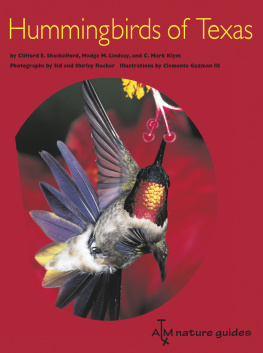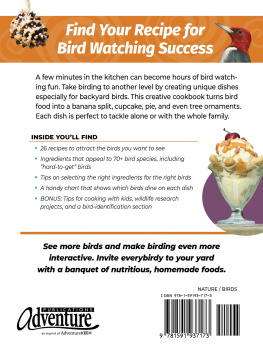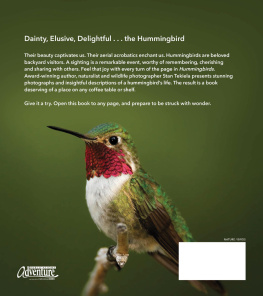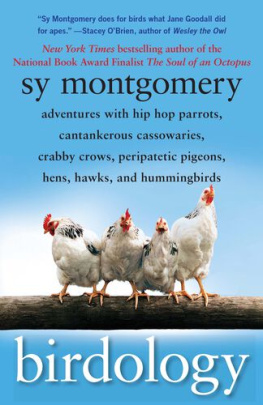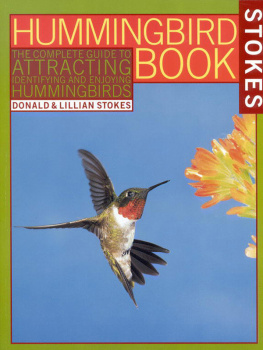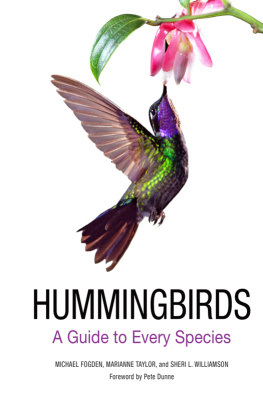This book features all the hummingbirds found in Texas and the southwestern United States and images of hummingbirds photographed in Texas, New Mexico, Arizona, Montana, California, Mexico, and Honduras. In the first half of the book, we look at some of the ways humans interact with these tiny birds and show how, through citizen-science projects and ecotourism opportunities, everyone can enjoy their company while helping to promote their well being. We give a few key instructions on how to plant gardens to attract larger numbers to your yard and how to provide protection for hummingbirds. Then we present some information about over-wintering trends and migratory behavior. In the second half of the book, we describe nineteen species of hummingbirds and offer new range maps and abundance graphs showing where and when they occur. For each, detailed artwork shows subtle differences to aid in the identification of male and female birds.

An interesting head-on view of the wings and spread tail of a male Annas Hummingbird. The family of hummingbirds, Trochilidae, is only found in the Western Hemisphere and reaches its highest diversity in the tropics, especially along the equator. There are more than three hundred species of hummingbirds found in the Americas. Of all the hummingbirds that breed in the United States, the range of Annas Hummingbird is the only one that does not extend south of the Tropic of Cancer.
ATXM nature guides
Hummingbirds of Texas
with Their New Mexico and Arizona Ranges

During flight, a hummingbirds heart can race at more than twelve hundred beats per minute. This male Black-chinned Hummingbird sports only a thin sliver of deep purple in the bottom half of its gorget. The upper half is a flat black, as the name indicates. The Black-chinned Hummingbird is the most familiar and ubiquitous species for the three-state area covered by this book.

Copyright 2005 by the Texas Parks and Wildlife Department Manufactured in China by Everbest Printing Co. through Four Colour Imports
All rights reserved
Third printing, 2014
The paper used in this book meets the minimum requirements of the American National Standard for Permanence of Paper for Printed Library Materials, Z39.48-1984.
Binding materials have been chosen for durability.

Library of Congress Cataloging-in-Publication Data
Shackelford, Clifford Eugene, 1967
Hummingbirds of Texas and their New Mexico and Arizona ranges / Clifford E. Shackelford, Madge M. Lindsay, and C. Mark Klym ; photographs by Sid and Shirley Rucker ; art by Clemente Guzman III.
p. cm.
Includes index.
ISBN 1-58544-433-2 (cloth : alk. paper)
1. HummingbirdsTexas. 2. HummingbirdsNew Mexico. 3. HummingbirdsArizona.
I. Lindsay, Madge M. II. Klym, C. Mark., 1959 III. Title.
QL696.A558H53 2005
598.7'64'09764dc22
2004028320
ISBN-13: 978-1-60344-110-0 (pbk.)
ISBN-13: 978-1-62349-081-2 (ebook)
: Male Ruby-throated Hummingbird
:
Hummingbirds do not migrate in flocks as waterfowl do, but they do congregate at feeders during southbound migration. Included at this single feeder are twenty-eight hummingbirds, mostly Annas, Rufous, and Black-chinned. Peak southbound migration in western hummingbirds is typically in the late summer in Texas, New Mexico, and Arizona. Late July to early August, for example, can be the best times to see events such as this. Southbound Ruby-throated Hummingbirds in Texas, however, usually peak in September.

The broad base to its red bill is the reason this species was named Broad-billed Hummingbird. In optimum lighting, the males of this species are the most shockingly iridescent of all the U.S. hummingbirds. The entire body can appear several different colors depending on the angle to the light, from a glittery green or blue to a dull, blacked-out look.
To our families and to all those who enjoy and love hummingbirds

Nectar-giving plants are extremely important to hummingbirds. This male Black-chinned Hummingbird is feeding on tree tobacco in South Texas. At certain angles to the light, the bright iridescent colors of the gorget can be completely blacked out. When used as a field mark, iridescence can appear to be a multicolored rainbow or even a mirage, thus playing tricks on the observer.
Acknowledgments
The authors wish to thank the hundreds of hummingbird watchers who reported unusual sightings and gave us new leads and a lot of information, making the Texas Hummingbird Roundup possible and also giving us the inspiration to write this book. Thanks go especially to Greg Lasley, former secretary of the Texas Bird Records Committee at the Texas Ornithological Society (TOS), who from the beginning helped with the Texas Hummingbird Roundup, developing range maps and providing other support. Also, we want to thank Mark Lockwood and Noreen Damude for their expertise in identifying birds from many photos, videos, and written sources. Mark Lockwood and Doug Altshuler provided technical guidance on the original artwork; their expertise on fine detail is much appreciated. Our thanks go to Keith Arnold at Texas A&M University, who archived photos and new county records and allowed us access to specimens in the Texas Cooperative Wildlife Collection. The photographers would like to thank the hummingbird fans who helped locate birds that were photographed for this book.
The Texas Hummingbird Roundup staff and internsKari Sutton, Kelly Bender, Jereme Phillips, Christina McCain, and others, who over the years helped to keep the Roundup goingreceive very special thanks. An additional thank you goes to John Herron and Pat Morton with the Texas Parks and Wildlife Department for helping to move this project high on the priority list. We would also like to thank Terry Johnson at the Georgia Department of Natural Resources, who allowed the Texas Parks and Wildlife Department to adapt the Texas Hummingbird Roundup from Georgias Hummingbird Helpers program. We are grateful to the many people who responded to our requests for information and would especially like to thank Russ Nelson, Steve Russell (Arizona), Christopher Rustay (New Mexico), and Jason Singhurst. Again, we would like to acknowledge Mark Lockwood, who spent a considerable amount of time assisting the authors; his expertise and willingness to share information are much appreciated. And finally, Shannon Davies and Jennifer Ann Hobson were instrumental in getting this book project completed.
Foreword
Greg W. Lasley
Hummingbirds are among the most fascinating creatures in the natural world. Although some other species of birds are able to hover, none do it with the masterful ability of a hummingbird. The hummingbirds ability to fly backward is unique among birds. Combine their aerobatic prowess with their endearing behavior of visiting our back porches and gardens and you have a combination that has captured the hearts of birders and nonbirders alike. So popular has the hummingbird become that the hummingbird feeder industry has grown exponentially across the United States in recent years. There are clubs devoted to hummingbirds, state programs developed to keep track of hummingbirds and the people who feed them, and entire festivals that draw thousands of participants to towns in several states, including Texas, to learn about these magnificent flying jewels. Our thirst for knowledge about these creatures seems to be never ending, and scores of books about hummingbirds have been published in the past decade.
Next page
